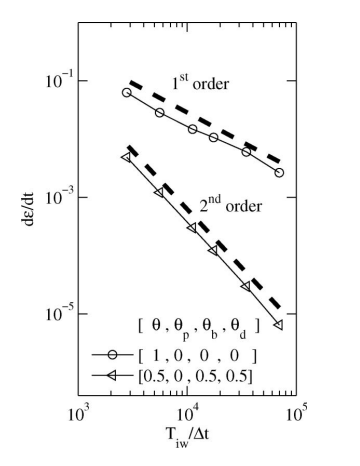Semi-implicit two-level predictor-corrector methods for non-linearly coupled, hydrostatic, barotropic/baroclinic flows
ABSTRACT: The unsteady shallow-water equations for barotropic/baroclinic (free-surface/density-stratified) flows with non-linear coupling of density transport and momentum are solved using a family of two-time-level, semi-implicit predictor–corrector methods (PC2). The PC2 methods are a general family that includes the popular TRIM method for hydrostatic flows. PC2 is characterised by four ‘θ’ parameters controlling the time ‘n’ and ‘n + 1’ weighting of (1) free surface gradient, (2) predictor step, (3) baroclinic gradient and (4) density temporal interpolation. Stability of the non-linear coupling between momentum and density transport for PC2 is examined in the inviscid limit. Central difference and quadratic (QUICK) spatial interpolation for density are compared. Second-order temporal accuracy for both barotropic and baroclinic flows is simultaneously obtained with appropriate θ parameters, which has previously been shown to be impractical for TRIM. The 2nd-order PC2 method has near-neutral non-linear stability (slightly positive amplification factor) where linear theory predicts exactly neutral stability. QUICK is shown to be preferable to central difference spatial discretisation to reduce the amplification factor. Adjusting the baroclinic weighting or adding small artificial viscosities can stabilise the model for non-linear internal wave simulations.
EXTRACT: Figure 8.

Figure 8. Baroclinic accuracy. Comparison of TRIM semi-implicit [\theta, \theta_p, \theta_b, theta_d] = [1, 0, 0, ½] and PC2 with explicit predictor [\theta, \theta_p, \theta_b, theta_d] = [½, 0, ½, ½].

